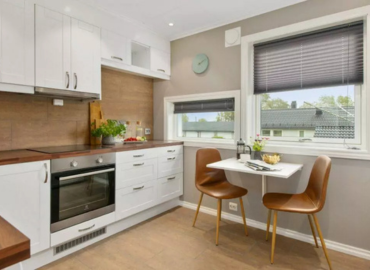Upgrading your kitchen tiles sounds simple—until it’s not. From choosing the wrong type of tile to layout blunders and sloppy sealing, even a minor misstep can throw your whole renovation off course. If you’re planning to retile your kitchen, it’s important to avoid the common pitfalls that many homeowners and even contractors fall into.
In this blog, we’ll break down 6 of the most frequent and frustrating kitchen tile renovation mistakes—and how to sidestep them. Whether you’re handling it DIY-style or hiring professionals, this guide will help you get your kitchen tile job done right the first time.
1. Choosing the Wrong Type of Tile
One of the biggest kitchen tile renovation mistakes starts right at the store—picking tiles that aren’t suitable for kitchen conditions. Some tiles may look stunning but aren’t practical. Think of using slick, glossy tiles in a kitchen where spills happen regularly. That’s a slip hazard waiting to happen.
Why It’s a Problem:
- Tiles not rated for floor use can crack or wear out quickly.
- Glossy tiles become dangerously slippery when wet.
- Light-colored or porous tiles may stain easily from spills.
What to Do Instead:
- Opt for ceramic or porcelain tiles designed specifically for floors.
- Look for non-slip surfaces, especially in cooking zones.
- Choose durable, stain-resistant finishes to handle heavy foot traffic and food mishaps.
2. Ignoring Subfloor Preparation
Even the highest quality tile will fail if it’s laid on an uneven or unstable surface. One of the more technical but common kitchen tile renovation mistakes is skipping subfloor inspection and prep.
Why It’s a Problem:
- Uneven subfloors can cause tiles to crack.
- Poor adhesion leads to tiles lifting or becoming loose.
- Moisture trapped under tiles can cause mold or mildew.
What to Do Instead:
- Check for dips, high spots, and moisture before installation.
- Use a self-leveling compound if needed.
- Ensure the surface is clean, dry, and primed for tile adhesive.
3. Bad Tile Layout Planning
Tile layout might seem like a cosmetic detail, but it plays a big role in the overall look of your kitchen. One of the more frustrating tile renovation errors is diving into installation without considering the layout and flow.
Why It’s a Problem:
- Uneven tile alignment disrupts the visual appeal.
- Awkward cuts at corners or edges look unprofessional.
- Patterns may not align with appliances or cabinetry.
What to Do Instead:
- Dry-lay a few rows of tiles before you commit to an adhesive.
- Use chalk lines or laser guides to maintain straight, even placement.
- Consider focal points, transitions, and grout line spacing.
4. Using the Wrong Adhesive or Grout
It’s not just about sticking tiles to the floor—using the wrong adhesive or grout can lead to peeling, cracking, and other headaches. It’s a sneaky kitchen tile renovation mistake that shows up a few months later.
Why It’s a Problem:
- Unsuitable adhesives weaken under kitchen heat and moisture.
- Grout that isn’t stain-resistant can discolor quickly.
- Incorrect mixing ratios can weaken the bond.
What to Do Instead:
- Always use adhesives suited for kitchen environments.
- Choose grout that’s water-resistant and easy to clean.
- Follow product guidelines strictly—no guesswork here!
5. Skipping Tile Sealing (Or Doing It Wrong)
If you’re using porous tiles like natural stone or even some ceramics, sealing is critical. Still, many people either skip this step or don’t reapply it when needed—an all-too-common kitchen tile renovation mistake.
Why It’s a Problem:
- Unsealed tiles absorb stains and oils.
- Water seeps into grout lines, leading to mold growth.
- Overall tile lifespan is reduced without proper sealing.
What to Do Instead:
- Seal tiles and grout lines after installation—especially if using porous materials.
- Use high-quality sealants and reapply periodically (as recommended by the manufacturer).
- Wipe up spills quickly even with sealed tiles to avoid long-term damage.
6. Underestimating Maintenance Needs
Renovating your kitchen tiles isn’t just a one-and-done project—it requires ongoing care. But too often, people don’t factor in future upkeep during the design or material selection phase.
Why It’s a Problem:
- Some tiles require regular sealing or special cleaners.
- Light grout colors stain easily without constant maintenance.
- Choosing overly textured tiles means more scrubbing down the road.
What to Do Instead:
- Consider lifestyle and maintenance before choosing materials.
- Go for darker grout shades to mask stains.
- Ask your supplier about cleaning and upkeep routines for your specific tile type.
Bonus Tip: Don’t DIY Unless You’re Confident
Tiling looks easy on YouTube tutorials, but it’s one of those jobs that’s better left to pros unless you have the skill and patience for precision work. Crooked lines, poorly spaced grout, and air pockets can turn a stylish renovation into a regret.
Final Thoughts: Nail Your Kitchen Tile Renovation by Avoiding These Mistakes
Renovating kitchen tiles isn’t just about picking a pretty pattern—it’s about planning, precision, and using the right materials for the job. By avoiding these 6 common kitchen tile renovation mistakes, you’ll save yourself time, money, and post-renovation headaches.
A stunning tile job can completely elevate your kitchen, but only if it’s done right. Take your time, consult professionals when needed, and invest in quality products that offer durability and long-term performance.
Looking for High-Quality Kitchen Tiles and Expert Advice?
Visit Chandan Marbles for a wide selection of stylish, durable kitchen tiles that suit every design and budget.
📍 Locations:
- Nagar Road, Pune
- Kharadi, Pune
- Marketyard, Pune
- Silvassa
📞 Call us at +91 8888843560
🌐 Or browse online at www.chandanmarbles.com
Let us help you tile your dream kitchen—without the mistakes!






